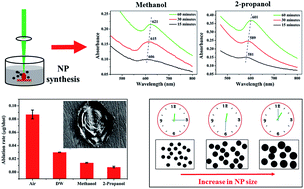Role of confining liquids on the properties of Cu@Cu2O nanoparticles synthesized by pulsed laser ablation and a correlative ablation study of the target surface
Abstract
The effect of confining liquid on the properties of copper nanoparticles synthesized by pulsed laser ablation in two organic solvents, methanol and 2-propanol is investigated along with the effect of the laser irradiation time on the synthesized nanoparticles. To understand the role of confining liquids on the formation mechanism of the nanoparticles in different environments, the results obtained in the organic solvents are compared to those obtained in distilled water. The increase in the average size of the nanoparticles from 7–19 nm with the laser irradiation time from 15–60 minutes is accompanied by a shift in the plasmonic peak towards longer wavelength from 606–621 nm, respectively in methanol. In the case of nanoparticles synthesized in 2-propanol, the average size of the nanoparticles increases from 9–17 nm and there is a corresponding shift in the SPR peak from 581–601 nm, respectively. The increase in the size of the nanoparticles with the increase in irradiation time in the organic solvents is the reverse trend of that obtained for nanoparticles synthesized in distilled water. The range of the plasmonic peak positions is blue shifted for the nanoparticles synthesized in methanol and 2-propanol as compared to that of 626–641 nm for the nanoparticles synthesized in distilled water indicating the formation of insufficiently oxidized nanoparticles in organic solvents. Formation of core–shell spherical copper nanoparticles with carbon encapsulation in methanol and 2-propanol is another interesting observation. The origin of the dependence of properties of the synthesized nanoparticles on the ambient liquid lies in the way the laser beam interacts with the target surface in the ambient. A detailed ablation study on the laser produced crater in all the three liquids is carried out to understand the factors that affect the properties of the nanoparticles.



 Please wait while we load your content...
Please wait while we load your content...